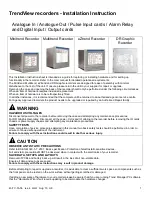
NorthEast Monitoring, Inc. NEMM019-Rev-O
Page 28 of 35
DR200/HE & DR300 Operator’s Manual
Appendices: Appendix C: Pacemaker Detection
Most chargers for NiMH batteries depend on a
property of these batteries that causes them to heat
up when they have reached full charge. This has
two consequences. First, if the batteries are being
charged in pairs, the first battery to be fully charged
will heat up and shut down the charge cycle. This
can leave one of the batteries partially charged.
Thus it is best to keep pairs of batteries together so
they are both discharged and charged together. Sec-
ondly, if the battery is too warm for any reason, it
may shut down the charge early. For that reason the
batteries should be charged at normal room temper-
atures and it is often best not to cover the batteries
in any way during the charge. Even the charger's
own cover may reduce the charge. Leave the cover
open during charging.
When the battery is not being charged, it will
slowly discharge by itself. This type of battery will
lose about one percent of its charge for each day.
Most chargers will bring a partially charged battery
up to full capacity in under an hour. Batteries that
have not been used for over two weeks should be
charged before use.
If used properly, these batteries will last for 300 to
1000 recordings of 7 days each. They will still not
last forever. To control battery life, writing the date
on the battery that the batteries are first put in ser-
vice can be helpful.
Nickel Cadmium
This type of battery has less capacity than the
NiMH and is not recommended. Also, disposal of
this battery can pose problems.
Battery Replacing
Insert a blunt object (for example, pen, coin or non-
pointy tool) in the space between the battery and the
top edge of the recorder. Press gently to easily
remove the battery.
To insert a fresh battery into the battery compart-
ment, be sure to orient it as indicated in the diagram
inside the compartment. The battery sits loosely in
the compartment.
Appendix C: Pacemaker
Detection
The recorder has a built-in pacemaker detection
capability. This was designed to overcome the prob-
lems inherent with the analysis of Holter recordings
from patients with pacemakers.
A pacemaker is designed to initiate cardiac conduc-
tion by stimulating a spot on the myocardium with a
pulse of 1-4 volts and a duration of typically 250 to
2,000 microseconds. When this pulse is seen at the
surface recording electrodes it is significantly atten-
uated. For patients with a unipolar electrode config-
uration, the signal at the surface may range from
under 50 to over 200 millivolts. When a bipolar
lead configuration is used, the signal is typically
much lower and is in the range of 3 to 50 millivolts.
Especially with the bipolar leads, the signal size is
dependent on the positions of the pacemaker lead
and the surface electrodes.
The amplitude of the signal being referred to here is
not the size of the "spike" commonly seen on an
ECG cart or bedside monitor. Since the duration of
the pulse is short compared to a QRS complex, nor-
mal ECG recorders will greatly attenuate the signal;
in some cases it cannot be seen at all. Also, some
ECG recorders have devices which enhance the
pace pulse to insure that it will be displayed. Only
very wide bandwidth recorders as are sometimes
used in an electro-physiology study will show the
unmodified full amplitude of the pulse.
The recorder has the wide bandwidth ECG amplifi-
ers necessary to pass the pacemaker pulse. Since the
pulse would still be too short to be recorded in a
reliable manner at any practical sampling rate for
Holter recording, the pulse is detected by the
recorder. The time of the pulse is then digitally
stored along with the Holter ECG data. When the
data is analyzed, the pacemaker pulse is displayed
and used for the analysis.
At recording time, it is desirable to have the
recorder be as sensitive to the pacemaker pulse as
possible so pulses will not be missed. A conflicting
requirement is that there should be as few false
pacemaker detections as possible.








































